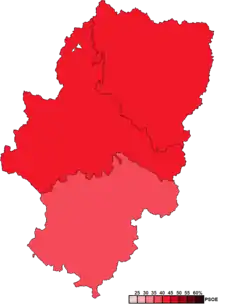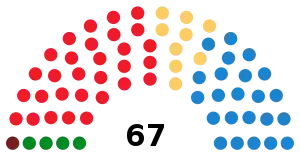2007 Aragonese regional election
The 2007 Aragonese regional election was held on Sunday, 27 May 2007, to elect the 7th Cortes of the autonomous community of Aragon. All 67 seats in the Cortes were up for election. The election was held simultaneously with regional elections in 12 other autonomous communities and local elections all throughout Spain.
| ||||||||||||||||||||||||||||||||||||||||||||||||||||||||||||||||||||||||||||||||||
All 67 seats in the Cortes of Aragon 34 seats needed for a majority | ||||||||||||||||||||||||||||||||||||||||||||||||||||||||||||||||||||||||||||||||||
|---|---|---|---|---|---|---|---|---|---|---|---|---|---|---|---|---|---|---|---|---|---|---|---|---|---|---|---|---|---|---|---|---|---|---|---|---|---|---|---|---|---|---|---|---|---|---|---|---|---|---|---|---|---|---|---|---|---|---|---|---|---|---|---|---|---|---|---|---|---|---|---|---|---|---|---|---|---|---|---|---|---|---|
| Opinion polls | ||||||||||||||||||||||||||||||||||||||||||||||||||||||||||||||||||||||||||||||||||
| Registered | 1,017,085 | |||||||||||||||||||||||||||||||||||||||||||||||||||||||||||||||||||||||||||||||||
| Turnout | 676,491 (66.5%) | |||||||||||||||||||||||||||||||||||||||||||||||||||||||||||||||||||||||||||||||||
| ||||||||||||||||||||||||||||||||||||||||||||||||||||||||||||||||||||||||||||||||||
 Constituency results map for the Cortes of Aragon | ||||||||||||||||||||||||||||||||||||||||||||||||||||||||||||||||||||||||||||||||||
| ||||||||||||||||||||||||||||||||||||||||||||||||||||||||||||||||||||||||||||||||||
The Spanish Socialist Workers' Party (PSOE), which had ruled Aragon since the 1999 election, saw an increase of three seats and obtained its best result since the 1983 election in terms of votes received. The People's Party (PP) also managed to slightly increase its vote share and gained one seat. On the other hand, the Aragonese Union (CHA) lost ground for the first time, losing 5 of its 9 seats and falling behind the Aragonese Party (PAR), which regained third place and increased its vote share for the first time since the 1987 election. United Left (IU) held its single seat and increased its vote share for the first time since 1995.
The PSOE and PAR renewed their coalition administration for a third consecutive time, resulting in Marcelino Iglesias being re-elected as regional President for a third term in office.
Overview
Electoral system
The Cortes of Aragon were the devolved, unicameral legislature of the autonomous community of Aragon, having legislative power in regional matters as defined by the Spanish Constitution and the Aragonese Statute of Autonomy, as well as the ability to vote confidence in or withdraw it from a President of the Government.[1] Voting for the Cortes was on the basis of universal suffrage, which comprised all nationals over eighteen, registered in Aragon and in full enjoyment of their political rights.
The 67 members of the Cortes of Aragon were elected using the D'Hondt method and a closed list proportional representation, with a threshold of 3 percent of valid votes—which included blank ballots—being applied being applied in each constituency. Parties not reaching the threshold were not taken into consideration for seat distribution. Additionally, the use of the D'Hondt method might result in an effective threshold over three percent, depending on the district magnitude.[2] Seats were allocated to constituencies, corresponding to the provinces of Huesca, Teruel and Zaragoza. Each constituency was entitled to an initial minimum of 13 seats, with the remaining 28 allocated among the constituencies in proportion to their populations on the condition that the seat to population ratio in the most populated province did not exceed 2.75 times that of the least populated one.[1][3]
The electoral law provided that parties, federations, coalitions and groupings of electors were allowed to present lists of candidates. However, groupings of electors were required to secure the signature of at least 1 percent of the electors registered in the constituency for which they sought election. Electors were barred from signing for more than one list of candidates. Concurrently, parties and federations intending to enter in coalition to take part jointly at an election were required to inform the relevant Electoral Commission within ten days of the election being called.[3][4][5]
Election date
After legal amendments in 2007, fixed-term mandates were abolished, instead allowing the term of the Cortes of Aragon to expire after an early dissolution. The election Decree was required to be issued no later than the twenty-fifth day prior to the date of expiry of parliament and published on the following day in the Official Gazette of Aragon, with election day taking place on the fifty-fourth day from publication. The previous election was held on 25 May 2003, which meant that the legislature's term would have expired on 25 May 2007. The election Decree was required to be published no later than 1 May 2007, with the election taking place on the fifty-fourth day from publication, setting the latest possible election date for the Cortes on Sunday, 24 June 2007.[1][3][4][5]
The President of the Government had the prerogative to dissolve the Cortes of Aragon and call a snap election, provided that no motion of no confidence was in process and that dissolution did not occur before one year had elapsed since the previous one. In the event of an investiture process failing to elect a regional President within a two-month period from the first ballot, the Cortes were to be automatically dissolved and a fresh election called.[1]
Opinion polls
The table below lists voting intention estimates in reverse chronological order, showing the most recent first and using the dates when the survey fieldwork was done, as opposed to the date of publication. Where the fieldwork dates are unknown, the date of publication is given instead. The highest percentage figure in each polling survey is displayed with its background shaded in the leading party's colour. If a tie ensues, this is applied to the figures with the highest percentages. The "Lead" column on the right shows the percentage-point difference between the parties with the highest percentages in a given poll. When available, seat projections are also displayed below the voting estimates in a smaller font. 34 seats were required for an absolute majority in the Cortes of Aragon.
- Color key:
Exit poll
| Polling firm/Commissioner | Fieldwork date | Sample size | Turnout | Lead | |||||
|---|---|---|---|---|---|---|---|---|---|
| 2007 regional election | 27 May 2007 | N/A | 66.5 | 41.1 30 |
31.1 23 |
8.1 4 |
12.1 9 |
4.1 1 |
10.0 |
| Ipsos/RTVE–FORTA[p 1] | 27 May 2007 | ? | ? | ? 31/34 |
? 20/23 |
? 4/5 |
? 6/7 |
? 2/3 |
? |
| C&J/El Periódico[p 2][p 3] | 20 May 2007 | ? | ? | 39.4 27 |
34.0 23 |
10.9 7 |
12.7 9 |
3.0 1 |
5.4 |
| A+M/Heraldo de Aragón[p 3] | 20 May 2007 | ? | ? | 37.8 26 |
33.1 23 |
11.0 8 |
12.8 9 |
3.6 1 |
4.7 |
| Celeste-Tel/Terra[p 4][p 5] | 9–15 May 2007 | ? | ? | 41.2 29/30 |
28.4 21/22 |
11.5 7 |
10.6 8 |
4.2 1 |
12.8 |
| Sigma Dos/El Mundo[p 6][p 7] | 27 Apr–8 May 2007 | 850 | ? | 41.4 28/30 |
32.0 22/24 |
10.9 7 |
9.3 7 |
3.4 1 |
9.4 |
| CIS[p 8][p 9] | 9 Apr–6 May 2007 | 1,538 | ? | 42.0 30/31 |
27.9 21 |
11.9 6/7 |
10.7 8 |
4.3 1 |
14.1 |
| A+M/DGA[p 10][p 11] | 3–11 Feb 2007 | 2,586 | 67.0 | 36.1 27 |
31.0 23 |
15.8 8 |
11.8 8 |
4.2 1 |
5.1 |
| Sigma Dos/El Mundo[p 12][p 13] | 16–24 Nov 2006 | ? | ? | ? 27/29 |
? 24/26 |
? 6 |
? 7 |
? 1 |
? |
| 2004 EP election | 13 Jun 2004 | N/A | 47.3 | 45.8 33 |
40.0 30 |
6.1 3 |
2.9 0 |
3.1 1 |
5.8 |
| 2004 general election | 14 Mar 2004 | N/A | 77.0 | 41.3 31 |
36.5 27 |
12.1 6 |
4.7 3 |
2.8 0 |
4.8 |
| 2003 regional election | 25 May 2003 | N/A | 70.4 | 37.9 27 |
30.7 22 |
13.7 9 |
11.2 8 |
3.1 1 |
7.2 |
Results
Overall
 | ||||||
| Parties and coalitions | Popular vote | Seats | ||||
|---|---|---|---|---|---|---|
| Votes | % | ±pp | Total | +/− | ||
| Spanish Socialist Workers' Party (PSOE) | 276,415 | 41.14 | +3.20 | 30 | +3 | |
| People's Party (PP) | 208,642 | 31.06 | +0.33 | 23 | +1 | |
| Aragonese Party (PAR) | 81,135 | 12.08 | +0.90 | 9 | +1 | |
| Aragonese Union (CHA) | 54,752 | 8.15 | –5.56 | 4 | –5 | |
| United Left of Aragon (IU) | 27,440 | 4.08 | +1.02 | 1 | ±0 | |
| The Greens–Federation of Independents of Aragon (LV–FIA)1 | 4,417 | 0.66 | +0.06 | 0 | ±0 | |
| Aragon United Citizens Party (pCUA) | 2,463 | 0.37 | New | 0 | ±0 | |
| Family and Life Party (PFyV) | 1,105 | 0.16 | –0.02 | 0 | ±0 | |
| Humanist Party (PH) | 577 | 0.09 | +0.04 | 0 | ±0 | |
| Blank ballots | 14,890 | 2.22 | +0.13 | |||
| Total | 671,836 | 67 | ±0 | |||
| Valid votes | 671,836 | 99.31 | –0.05 | |||
| Invalid votes | 4,655 | 0.69 | +0.05 | |||
| Votes cast / turnout | 676,491 | 66.51 | –3.85 | |||
| Abstentions | 340,594 | 33.49 | +3.85 | |||
| Registered voters | 1,017,085 | |||||
| Sources[6][7][8] | ||||||
Aftermath
| Investiture Marcelino Iglesias (PSOE) | ||
| Ballot → | 5 July 2007 | |
|---|---|---|
| Required majority → | 34 out of 67 | |
39 / 67 | ||
28 / 67 | ||
| Abstentions | 0 / 67 | |
| Absentees | 0 / 67 | |
| Sources[8] | ||
References
- Opinion poll sources
- "Sólo Navarra y Baleares podrían cambiar de gobierno, según el sondeo de RTVE y FORTA". Europa Press (in Spanish). 27 May 2007.
- "El PSOE volverá a ganar y el PAR le disputará a CHA la tercera plaza". El Periódico de Aragón (in Spanish). 20 May 2007.
- "El PSOE volvería a ganar las elecciones y podría pactar con PAR o CHA". 20minutos (in Spanish). 20 May 2007.
- "Vuelco electoral en Navarra, Baleares y Canarias y aplastante victoria del PP en Madrid". Terra (in Spanish). 17 May 2007. Archived from the original on 20 May 2007.
- "Encuestas autonómicas". Celeste-Tel (in Spanish). 17 May 2007. Archived from the original on 11 May 2009.
- "Sondeo de Sigma Dos: El PSOE mantendría sus comunidades si revalida las coaliciones". El Mundo (in Spanish). 13 May 2007.
- "Elecciones 27-M / Sondeo El Mundo-Sigma Dos". El Mundo (in Spanish). 12 May 2007.
- "Preelectoral elecciones autonómicas, 2007. CA de Aragón (Estudio nº 2687. Abril-Mayo 2007)" (PDF). CIS (in Spanish). 11 May 2007.
- "La aritmética juega en contra del PSOE sólo en las islas Canarias". La Vanguardia (in Spanish). 12 May 2007.
- "La intención de voto de los aragoneses se mantiene estable en relación a las elecciones autonómicas de 2003". Aragón Hoy (in Spanish). 12 March 2007.
- "El voto a las Cortes sigue estable pero el PP gana un diputado". El Periódico de Aragón (in Spanish). 13 March 2007.
- "El PP y el PSOE mantendrán sus gobiernos autonómicos, aunque los socialistas bajan". El Mundo (in Spanish). 27 November 2006.
- "El voto en las comunidades. Elecciones autonómicas 2007" (PDF). El Mundo (in Spanish). 27 November 2006.
- Other
- "Statute of Autonomy of Aragon of 2007". Organic Law No. 5 of 20 April 2007. Official State Gazette (in Spanish). Retrieved 17 September 2017.
- Gallagher, Michael (30 July 2012). "Effective threshold in electoral systems". Trinity College, Dublin. Archived from the original on 30 July 2017. Retrieved 22 July 2017.
- "Autonomous Community of Aragon Electoral Law of 1987". Law No. 2 of 12 February 1987. Official Gazette of Aragon (in Spanish). Retrieved 17 September 2017.
- "General Electoral System Organic Law of 1985". Organic Law No. 5 of 19 June 1985. Official State Gazette (in Spanish). Retrieved 28 December 2016.
- "Representation of the people Institutional Act". www.juntaelectoralcentral.es. Central Electoral Commission. Retrieved 16 June 2017.
- "Cortes of Aragon election results, 27 May 2007" (PDF). www.juntaelectoralcentral.es (in Spanish). Electoral Commission of Aragon. 18 June 2007. Retrieved 26 September 2017.
- "Aragon Electoral Archive. Cortes of Aragon election, 2007. Autonomous Community of Aragon". servicios.aragon.es (in Spanish). Government of Aragon. Retrieved 26 September 2017.
- "Elecciones a las Cortes de Aragón (1983 - 2019)". Historia Electoral.com (in Spanish). Retrieved 26 September 2017.
.jpg.webp)

.jpg.webp)

.jpg.webp)